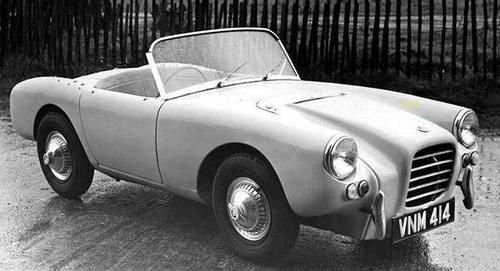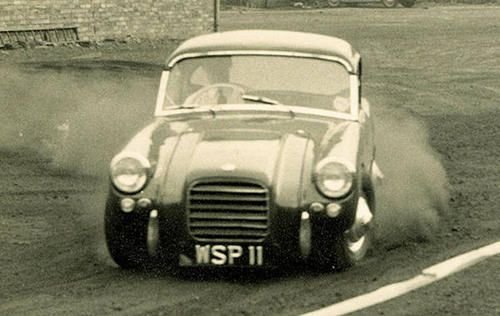Berkeley B95 B105
 |
|
| Production | Mar 1959 – Dec 1960 200 approx produced. |
|---|---|
| Body style | 2-door roadster |
| Engine | 692 cc transverse four stroke twin, air-cooled |
| Wheelbase | 70 in (1,778.0 mm) |
| Length | 125 in (3,200 mm) |
| Width | 50 in (1,270.0 mm) |
| Height | 45 in (1,143.0 mm) |
The B95 and B105 models were launched at the 1959 Geneva Motor Show and boasted more power from twin-cylinder Royal Enfield 692 cc four-stroke engines, with the 40 bhp (30 kW; 41 PS) Super Meteor engine in the B95 and the 50 bhp (37 kW; 51 PS)
Show since the marque's switch-over from two-stroke to four-stroke power. Engine of the B95 sports two.seater, in common with the reat of the range, is now a vertical twin,fitted to some of the larger Royal Enfield motorcycles, The 4-gpeed gearbox, too. is of motorcycle type, with two-stage chain transmission.
The rest of the specification follows familiar Berkeley practice, with all- independent suspension (swinging half-axles at the back, wishbones in front, coil springs at both ends), and
a unitary hull made from resin-bonded glass-fibre with light alloy reinforcements at critical points.
Constellation unit in the B105 which could reputedly exceed the magic 100 mph (160 km/h). The engines featured Berkeley-design primary chain cases to accommodate a Lucas Bendix starter motor, an external Lucas dynamo mounted above the gearbox, and a duplex (or double-row) chain drive to the differential. Kerb weight increased to 402 kg (890 lb). B95 engine numbers have the unique prefix 'SMTB', while B105 engines are prefixed 'SMUA'.
- Power: B95 41 @ 5.500 rpm B105 51 hp @ 6.250 rpm
- Fuel consumption: 45 mpg
- Top speed: 70mph
The prototype car was SE492 chassis number 638, which was modified to add bracing to withstand the extra power and weight of the four-stroke engine, a taller bonnet (US hood) with large grille to accommodate the engine, and unfaired headlights. In mid-February 1959 this car spent two weeks at the Royal Enfield factory, during which time it covered 500 miles of general road use and 1,000 mi (1,600 km) of endurance testing at MIRA.
By the time of the press release announcing the launch of the B95 in March 1959, a further 2,500 mi (4,000 km) of road and track tests had also been carried out by Berkeley factory drivers. Perhaps to address the reputation for breaking down that the two-strokes had developed, especially in export markets, it was emphasised by the factory that during this testing there had been no involuntary stops or any form of mechanical failure, and that further testing would be performed until a total of 15,000 mi (24,000 km) had been completed.
At its launch, the B95 cost £659 fro hard top and £627 for soft top version . About 200 B95 and B105 models were made, with chassis numbers following-on from the SE492 series and chassis number 670 (the earliest known B95) was registered at the end of March 1959. The first B105, chassis number 686, was delivered about one month later from 1960 chassis numbers from 834 up.
About half of the four-stroke cars were exported, and both the B95 and B105 were in production at the time the company was declared insolvent in December 1960. A few cars were assembled from parts following the factory's closure.

Technical
-
Berkeley B95 B105 Technical details and specifications (1959-1960)
ENGINE:
Cubic Capcity: 692 c.c
Bore: 70 mm.
Stroke: 90 mm.
Valves: over head
Compression ratio: 7.25:1
Carburettor: Amal
Fuel capicty 5.5 GallonsTRANSMISSION DRIVE LINE:
Gearbox:Albion 4 speed
Gearbox ratios: 1st 4.31 2nd 5.95 3rd 8.62 4th 13.7
gear lever location: centralSUSPENSION:
Front:Ind. hyraulic shock absorbers
Rear: Ind.DIMENSIONS AND WEIGHT:
Length : 10 ft. 5.5 in
Width 4ft 2in
Height:3ft 10 in
Ground clearance: 7 in
Track Front : 3 ft. 6.5 in
Track Rear: 3 ft. 6 in
Wheelbase: 5 ft. 10 in
weight 7 cwt
Turning Circle : 28 ft.© Motor car History
